The following material was originally contained in the Jefferson County School News Vol. 2, No. 8 dated May 1976 and graciously provided by its Editor, Mary Stocks.
In 1976 Jefferson County School News was a monthly publication sponsored by the Board of Education as a public service to Jefferson County residents.
Superintendent - Harold L. Pickens
President of the Board - Richard Neal
Editor - Mary Stocks
Special thanks are due to the following people who so willingly supplied information to the editor of this paper for this special publication:
Miss Gladys Hartzell, Mrs. Mary Baum, Mr. and Mrs. Robert Rissler, Mr. Mayo Snyder, Mr. Charles Reinhart, Mrs. Augusta Phillips, Mr. Franklin McQuilkin, Miss Helen Goldsborough, Mr. Joe Walper Mr. Oscar Jones, Mrs. Mary Donley Reinhart, Miss Mildred Conard, Rev. Lester Link, Mr. Kerfoot Moler, Mrs. Adora Payne, Mrs. J. W. Link, Mrs. Elsie Garrett, Mrs. Robert Knott, Mr. Thomas Turner, Mrs. Marion Creamer, Mr. Arthur Prather, Mrs. Robert Knott, Mr. B. M. Dennis, Mrs. Mary Ennis, Mr. Jesse Engle.
Jefferson County Public Schools
Shepherdstown District School History
1847-1933

Two residents of Shepherdstown, Arthur Prather and Gladys Hartzell, are pictured at the stone foundation which is all that remains of Potomac School, probably built in 1847. The foundation is directly behind the Carolyn Apartments.
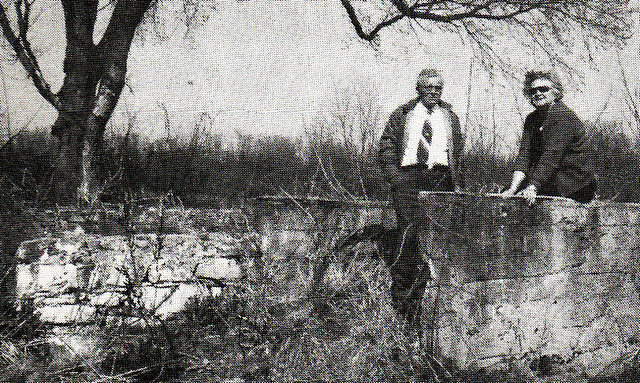
When Jefferson County voters on June 3, 1847, (see SCHOOL NEWS "Looking Back," January, 1975) voted to establish a free public school system, Shepherdstown was divided into two school districts. The western part of town was the Potomac District while the eastern part was the Shepherd District, and each district was responsible for maintaining a schoolhouse.
According to Musser's HISTORY OF SHEPHERDSTOWN, a lot was purchased that same year at the extreme west end of Washington Street for the erection of a school building for the Potomac District. It was a one-room brick building and was called Potomac School.
The school stood 200 feet north of the entrance of Leeland, now the home of Miss Helen Goldsborough whose grandmother attended Potomac School.
The Shepherd District purchased a lot in 1849 at the intersection of Princess and New Streets for $100 from Samuel Baker, Henry Taylor, and John White. A one-room brick school was erected on this lot and was called Shepherd School.
The Potomac and Shepherd Schools were both in operation until 1880 when the commissioners of the two districts joined to purchase the old county jail building on the northwest corner of High and King Streets in Shepherdstown for use as a consolidated school.
Potomac School was sold in 1881 to Edmund Lee, the great-grandfather of Helen Goldsborough, for $416.50. Lee lived at Leeland and probably rented the school as a private dwelling. Later, an Annie Washington lived in the school for many years. Finally G. L. Waltz purchased the school and tore it down a few years ago.
The stone foundation is all that remains of Potomac School. The Carolyn Apartment complex owned by G. L. Waltz sets directly in front of the foundation.
Shepherd School was sold in 1881 to a William L. Reinhart for $383. For many years the school was used as a private dwelling and later as a grocery store by Frank Carter.
In 1944, Shepherdstown Mayor U. S. Martin purchased the building from Carter. After Martin's death in 1957, his son Upton Martin of Richmond, Va., became owner of the former school.
In 1961, Upton Martin deeded the school to the State of West Virginia for Shepherd College in memory of his father who had been a leading citizen of Shepherdstown for over 50 years.
The little red brick school still stands today. The Historic Shepherdstown Commission is in the process of restoring the building. The restoration of the outside of the school is complete, but the Commission's plans to authentically restore the inside have not been completely carried out to date.

Shepherd School still stands today on Princess Street in Shepherdstown. It was built soon after Jefferson County voters established a free school system in 1847.
In 1881 the commissioners of the two districts joined to purchase the old county jail building on the northwest corner of High and King Streets in Shepherdstown.
The building had been used from 1865 until 1871 as a jail when the county seat had been located in Shepherdstown.
A portion of the old jail was repaired and converted into classrooms and was used as a school until 1900 when a ten-room brick school building was erected on the same lot. The jail was razed when the new school was ready for occupancy.
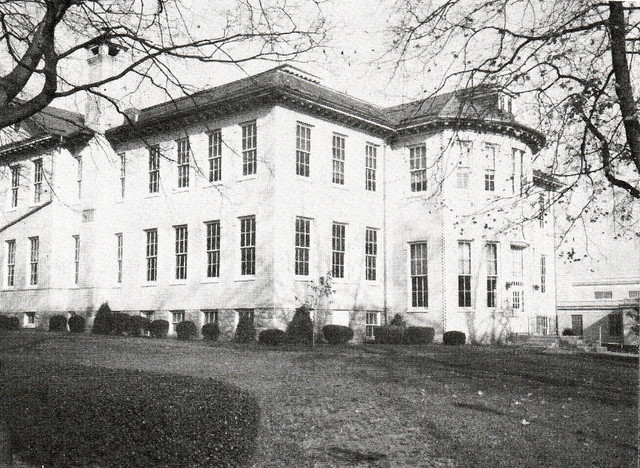
Shepherdstown Graded School - 1900
The new Shepherdstown Graded School served grades one through eight until 1920 when a ninth grade class was added. This addition was the first experience in public high school education for Shepherdstown. Since 1872, students above the eighth grade had paid tuition to attend high school at Shepherd College.
The new ninth grade class was taught by the school's principal George Knode. This arrangement continued until 1922 when the Board of Education rented McMurran Hall, then called "Old Shepherd College Building," to organize a secondary program for grades 9-11.
According to the Shepherdstown District Board of Education minutes of 1925, Shepherdstown Graded School was rented during the summer months for $50 by Shepherd College for use as a summer school.
The rent originally was set at a much higher rate, but in return for the Board's lowering the rent, the college offered a summer class in remedial work to any eighth grader who needed to make-up school work.
It seems that the college and the school maintained a close working relationship throughout the years. College students in training to become teachers often worked in the graded school. In fact, in 1931, there were so many first graders enrolled at Shepherdstown Graded School that a college student was obtained to ''take over the teaching of some."
Shepherdstown Graded School served both the students of Shepherdstown and of the surrounding rural areas. The consolidation of the rural schools into the Shepherdstown School was always a main goal of the Shepherdstown District Board of Education.
In 1915 the Shepherd's Grade School was closed to consolidate with Shepherdstown. Oak Grove followed in 1917, Molers Crossroads and Uvilla in 1928, and Duffields and Edgewood in 1929. Shepherdstown Graded School continued to operate until 1957 when it was replaced by the present Shepherdstown Elementary School in Little Run Acres.
The graded school built in 1900 is now a part of the Shepherd College campus, used as the social sciences building until recently. The building will be razed in the near future to clear the site for a new college building to house the home economics and nursing departments.
Black Schools
Because of the lack of records, it is not possible to establish the exact date for the building of the first school for black students in Shepherdstown.
However, the building still stands today on Brown's Alley.
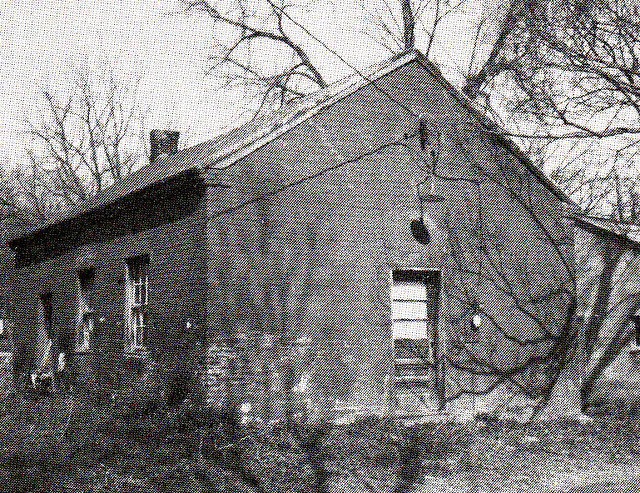
It was a one-room brick school called Old School which operated until 1883 when Shadyside, a larger frame structure on West High Street was rebuilt to replace it.

The Old School is the property of the Asbury Methodist Church and until recently has been used as a private dwelling.
School commissioners purchased the lot for Shadyside from a R. A. Hessey for $65. This larger school operated until it was replaced by Eastside School in 1948.
Shadyside was sold in 1948 to Knode Tennant for $910. Later it was sold to Belle Allen who operated a tavern in the former school for many years. Today Shadyside is owned by the heirs of Belle Allen, but it is not being used for any purpose.
Shepherdstown Begins High School Program
In 1922, the Shepherdstown District Board of Education offered for the first time a high school program beyond the ninth grade.
Two years earlier a ninth grade class was started at Shepherdstown Graded School, but students beyond the ninth grade still paid tuition to attend high school at Shepherd College.
The secondary program organized in 1922 served grades 9 -11 in the "Old Shepherd College Building" (McMurran Hall) which was rented from the State of West Virginia by the Board.
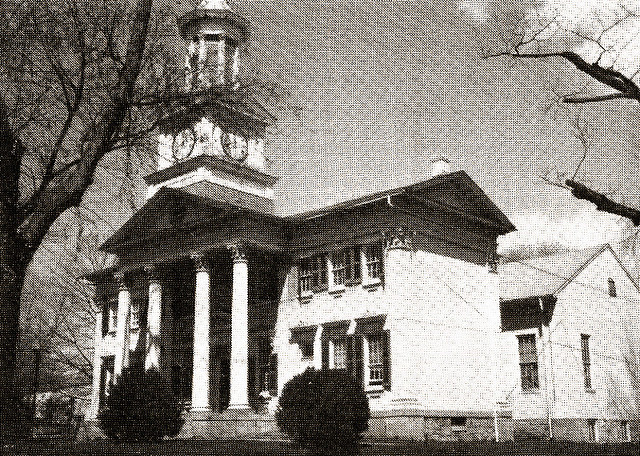
The old Shepherd College Building (McMurran Hall) was used as a high school from 1922 - 1939
In 1926 a full high school program for grades 9 -12 became a reality. John Lowery, father of former Superintendent of Schools, T. A. Lowery, served as principal and mathematics and Latin teachers. English was taught by Gladys Hartzell and three other staff members taught social studies, science, agriculture, and home economics.
The Board of Education set high standards for its high school students. A policy formulated in 1924 stipulated that any scholars who failed in two subjects in the first semester would be dropped from school and not allowed to continue their studies without permission from the Board.
Seven students failed at least two subjects in the first semester of 1924. Six were allowed to return if they could pass an examination on the subjects failed and if they passed all subjects at the end of the second semester. The other student had failed all subjects and was not allowed to return to school.
The college building was evidently less than satisfactory for use as a high school. R. Emerson Langfitt of the West Virginia Department of Education visited the high school in 1927. His evaluation, quite critical of the facilities, mentioned that one room was being used as a library, principal's office, study hall, classroom, lunch service room, and locker room. He pointed out that most of the books in the library were textbooks and that no toilet facilities were available.
However, many citizens of the Shepherdstown District were not in favor of building a new high school. Bond issues to provide a new high school were put before the public twice in 1924 and again in 1927. All three times, the levies were defeated by a heavy margin.
It was not until 1928 that a $40,000 bond issue was finally passed, 778 votes for and 291 against. High school classes continued to be held at McMurran Hall until the new high school was completed in 1930.
The new Shepherdstown High School was built on a five-acre lot purchased from the Baltimore and Ohio Railroad for $4000. F. 0. Trump was, awarded the construction contract for $33,000.
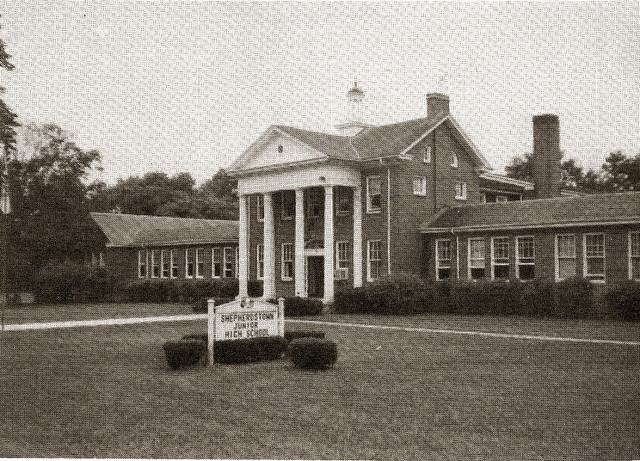
Shepherdstown High School - 1930
The new school served grades 7-12 until 1971 when grades 10 -12 were moved to a new consolidated county high school on the Flowing Springs Road.
The school is now Shepherdstown Junior High serving grades 7 - 9.
Lemen (Oak Grove) School

One of the earliest public schools in Jefferson County was built on the Lemen farm, one mile west of Shepherdstown on the Martinsburg road.
The deed for property was recorded in 1857. Willoughby and Esther Lemen sold the lot to the school commissioners for $40. However, the school must have been built prior to 1857.
A cornerstone, now on the front corner of the Jefferson County Court House, was placed on the Lemen School in 1851 to honor John Yates, the first president of the county school commissioners elected in 1847 to implement a system of public schools in Jefferson County.
Lemen School is better known to Shepherdstown residents as Oak Grove School. The one-room school continued to operate until 1917 when it was consolidated with Shepherdstown Graded School.
In 1926, Oak Grove was sold to the estate of David Lemen for $150. The school was torn down some years ago. Today the former site of the school is part of the Fred Gates property.
Edgewood Schools

Edgewood School, 1904 - Now a Private Residence
According to Mayo Snyder of Martinsburg, a former student of Edgewood School, there has been a total of three Edgewood Schools, the first two destroyed by fire.
It is unknown when the first Edgewood School was built. The earliest deed recorded is for the year 1879 when a George Moore deeded to the Board a lot "on the road leading from the Ridge Road to Walper's Cross Roads" for one dollar as long as the land was used for school purposes.
Snyder does not know whether the 1879 school was the first or second Edgewood, but he does know that both schools were built in the same general area.
Sometime around 1904 the second Edgewood School was destroyed by fire and the third Edgewood was built, again in the same general area.
The last Edgewood was a one-room brick school which still stands today. It was used until 1929 when it was consolidated with Shepherdstown Graded School.
In 1930 Edgewood was sold to a Gilbert Hendricks for $450. Today the school is owned by Clarence Dunn who uses it as a private residence.
An interesting story concerning Edgewood is told by Joe Walper of Shepherdstown who attended the school in the early 1900's. He says that some of his classmates used to set the clock up to trick their teacher, Annie Eickelberger. He remembers being sent home many days at 1:30 pm when his teacher looked at the clock and announced it was 4 pm.
Unionville (Uvilla) Schools
Although it is not known when the first public school in Uvilla (formerly Unionville) was established, it is known that there was a school there in 1850.
Gladys Hartzell in her book, ON THIS ROCK, THE STORY OF ST. PETER'S CHURCH, quotes from the church records: "In 1850 the Lutherans ceded their interest in Zion Church (Bakerton) to the Presbyterians and held services, conducted by the Reverand Dr. Schmucher in the old log school house at Unionville."
The Lutherans continued to meet in the school until they erected their first church called Luther Chapel in 1856 on adjacent property owned by Isaac Dust.
The school house was also on Dust property. The deed for the school lot was not recorded until 1872. The deed states that for one dollar, Isaac Dust granted the northwest corner of the Lutheran Church lot to the school commissioners as long as the land was used for school purposes. The land was to revert to the family if a school house ceased to be located there.
It is not known why the deed was recorded so many years after the school was erected. Perhaps the school existed as common school before the public school education was established in Jefferson County in 1847. In any case, it was not uncommon for landowners to have schools built upon their property without any kind of deed transfer.
The first Uvilla school was used until around 1897 when it was replaced by a two-room brick school which still stands today. Now a private residence, the school is located next to the Lutheran Church which was built in 1896 to replace Luther Chapel.
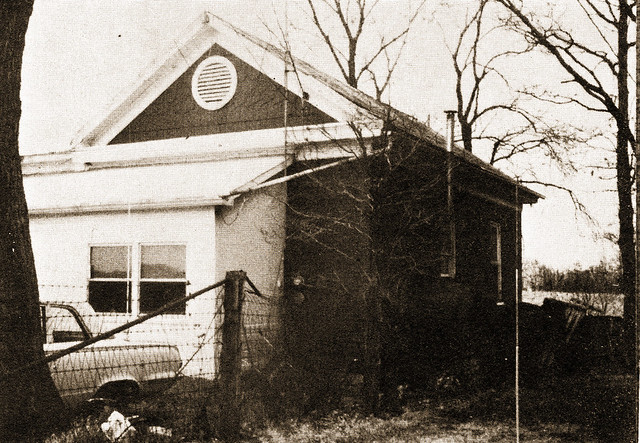
Although many changes have been made to the building pictured, the original structure was built in 1897 as the Uvilla school. It replaced an earlier school which dated back at least to 1851. Today the school pictured is the home of Marion Creamer.
The new brick school served the Uvilla area until 1928 when it closed to consolidate with Shepherdstown Graded School.
In 1929, a Mr. Merchant bought the school from the Board of Education for $400. Merchant remodeled the school for a private dwelling. Today his daughter, Marion Creamer lives there. She recalls that when her father bought the school, the Board moved the blackboards and desks to the nearby Skeetersville School.
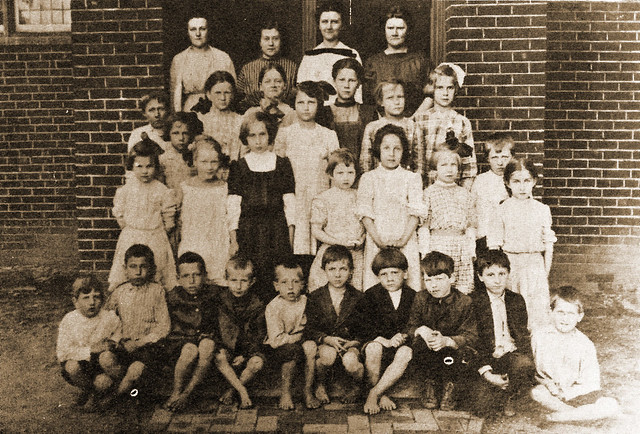
This picture was taken in front of the Uvilla School around 1912. It was loaned to SCHOOL NEWS by Mildred Conard, a long-time resident of the Uvilla area. Pictured:
Front row are: ?, Richard Hawn, ? , Olin Hawn, ? , Daniel Engle, ? , Franklin Jones, Howard Albin, and Gilbert Hendricks.
Second row: Betty Engle, ? , Agnes Comer Gay, ? , Ruth Myers, Anna Hendricks Edwards, Kenneth Engle, and Mary Hendricks Ennis.
Third row: ? , Gladys Moler, and Bessie Henkle Welsh.
Fourth row: Jesse Engle, Viola Engle, ? , ?
Fifth row: Meta Jenkins, Grace Comer, Helen Link (teacher) and Lallie Maddex (teacher).
Moler's Crossroads Schools
According to life-long residents of Moler's Cross Roads, there have been at least three schools in the small community.
Of these three, only the first still stands today. It is located one and one-half miles out of Molers Cross Roads on the road to Shepherdstown and is now the residence of Sidney Jenkins.
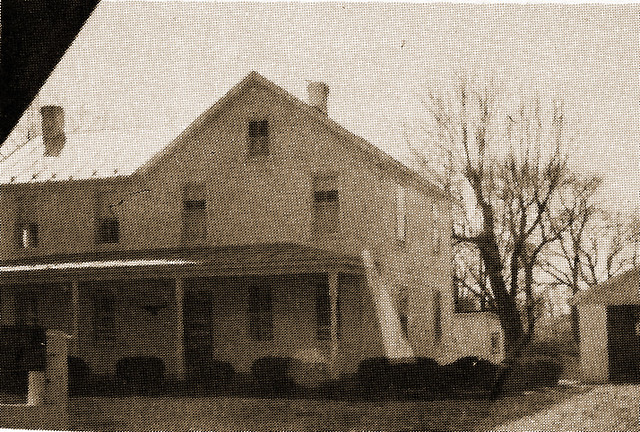
This home, one and one-half miles outside of Moler's Crossroads, was originally a one and one-half story log building used as a school in the 1840's.
According to Kerfoot Moler, a descendant of the Molers for whom the community is named, his great aunt Victoria Moler, born in 1842, went to this school.
This school was originally a one and one-half story log building, but of course many changes have been made over the years. The former school is now a two-story home with several rooms added.
It is not known whether this school was a common or private school, but it probably remained open until the Reinhart School was built, sometime around 1850.
The exact date the Reinhart School was erected is not known. In 1860 Christian Reinhart deeded the school commissioners the lot on his farm where the school stood, but the school was built several years before.
The Reinhart School can be traced back as early as 1851 according to Mrs. Nellie Hendricks Moler in her booklet, "History of the Founding of Bethesda M. E. Church South," written in 1934.
In writing the church history, Mrs. Moler found that the Reinhart School was used for many years as a church meeting house before the Bethesda Church was built in 1874. The following excerpts from the booklet tell much about the Reinhart School.
"Bethesda is sixty years old. The History of Bethesda needs to go back to the old Reinhart Schoolhouse days, when that schoolhouse was the center of a rural community church on the Sabbath day, and the forum of the "Three R's" on week-days.
It was a brick structure, built on land owned by Christian Reinhart, and now owned by Dr. S. T. Knott. The lot was at the east edge of a beautiful woodland of oaks and hickories, on the road leading to Dr. Knott's home. It faced the road, with three windows on either side and none at the back.
This building was used for school during the week, and on Sunday in the afternoons, for services; class meeting, singing, Bible reading, Sunday School; and at night, prayer meeting.
The first record of a service held in Reinhart's Schoolhouse was in 1851. At that time, it was recorded as one of the classes on "Shepherdstown Circuit," and called "Class No. 7," leader and "exorter" Michael Nichols. There were eleven classes-two being for colored slaves but having white leaders-and all held at different places."
Reinhart School was torn down in 1880 when it was replaced by a school built on property sold to the Board of Education by D. G. Moler (grandfather of Kerfoot Moler) for $45. The bricks from Reinhart were used as filler in the walls of the new school which also came to be known as Reinhart School.

Kerfoot Moler, a descendant of the Molers for whom Molers Crossroads is named, stands on the stone foundation of the second Reinhart School, built in 1880. The school was built on land sold to the school commissioners by his grandfather, D. G. Moler. The school stood approximately 150 yards north of the Bethesda Church.
According to Mary Reinhart Donley, another life-long resident of Molars Cross Roads, the new school was originally a one-room school, but around 1899 a second room was added. Mrs. Donley was both a student and a teacher at this school.
Reinhart School finally closed in 1928 to be consolidated with Shepherdstown Graded School. In 1929 the school was sold to the heirs of D. G. Moler for $475. The school was torn down a few years ago, and the former site of the school is the property of E. G. Moler, brother of Kerfoot Moler.
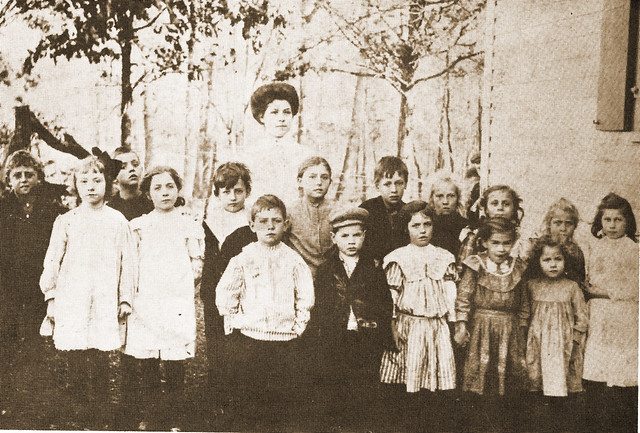
These school children were students of the Reinhart School built in 1880. This picture, loaned to SCHOOL NEWS by Kerfoot Moler, was taken sometime in the early 1900's.
Front row are Mabel Thompson, Phoebe Knott, Kerfoot Moler, Peck Hoffman, Eva Knott Spring, Dovie Walters, and Margaret Skinner Shultz.
Back row are Christian Carter, Charles Myers, Jacob Myers, Charlotte Carter Lowe, Charles Springer, Maude Marshall Sager, Margaret Dobson, Lily Marshall, and Inez Moler. The teacher is Bess LaMar Rau.
Duffields Schools
In 1870, the Elk Branch Church in Duffields built a school for the community next to the church. The school was called The Academy and was the only school in Duffields until the Shepherdstown District Board of Education built a school nearby in 1885.
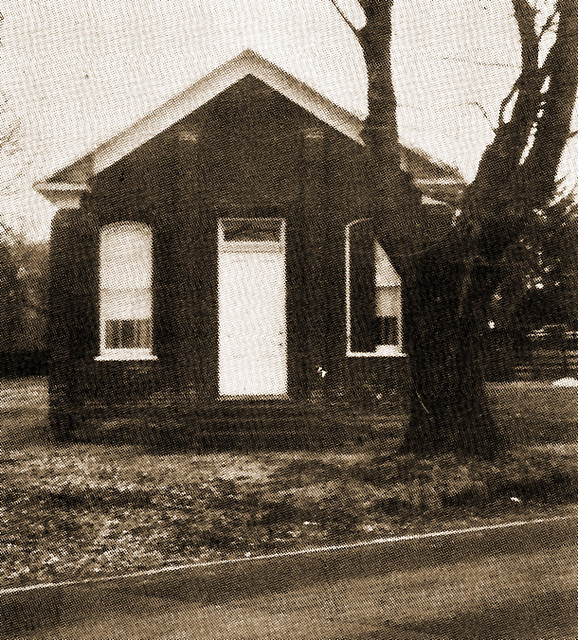
The Academy - 1870
Land was purchased for the school from a John Harman for $125. A one-room school was built and was originally used for grades five through eight, while the younger students continued to attend school at The Academy.
Although the exact date is unknown, The Academy was eventually closed and the Duffields School began to serve all eight grades until it was consolidated with Shepherdstown Graded School in 1929.
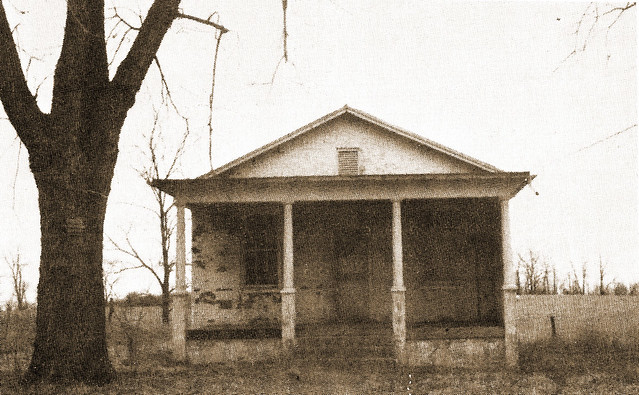
The Duffields School - 1885
Today both The Academy and Duffields School still stand. The Academy is used by Elk Branch Church for community meetings and suppers. Duffields School was sold in 1934 to Dr. W. J. Melvin for $135. His daughter, Mrs. Robert Rissler of Duffields, owns the school building today.
The school for black students in the Duffields area was called Skettersville School. It still stands today one mile from Duffields on the Duffields-Uvilla Road.
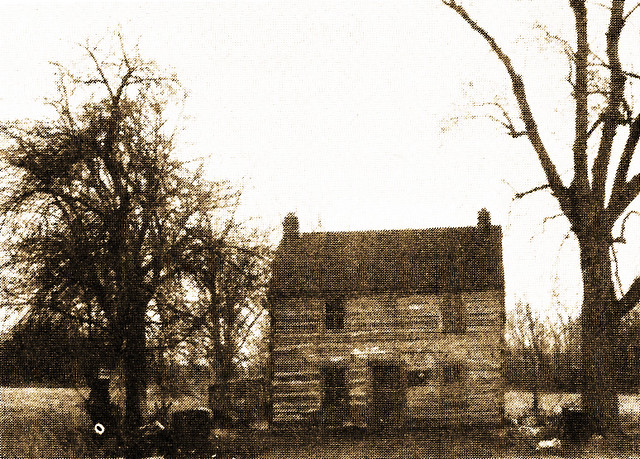
Skettersville School
It is unknown when this school was established since there are no early records of the Shepherdstown school district.
The deed for the property was recorded in 1920 showing that the building and the land was sold to the Board of Education by a James Mason, Jr. for $850. However, the school was in use at least by 1912.
According to B. M. Dennis of Harpers Ferry, teacher at Skeetersville around 1913, the building was originally a private residence with one room rented for use as a school.
In 1924, patrons of the Duffields area asked the Board to furnish new and better quarters for the school, but no action was ever taken.
Skettersville continued to operate until 1937 when it was sold for $275 to a Nathaniel Gray who rented it as a private residence. Today the former school is the home of James Motten.
Shepherd Grade Area
Turner School and Shepherd's Grade School
Turner School was built in 1770 as a private school but it later became a public school serving students in the Shepherd Grade area.
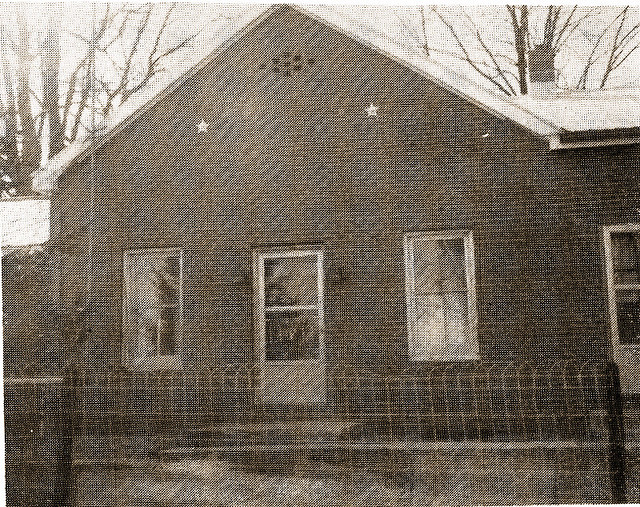
Shepherd's Grade School, now a Private Residence
According to Thomas Turner, a descendant of the original owners of Turner School, it was probably not until the later part of the 19th century that Turner School finally closed its doors.
The school was located three miles north on the road to Scrabble from Shepherdstown. Turner believes it was destroyed by fire.
Turner School was replaced by Shepherd's Grade School, a one-room brick school about four miles out of Shepherdstown on Shepherd Grade.
It is believed Shepherd's Grade School closed around 1915 when it was consolidated with Shepherdstown Graded School.
The Board of Education rented the school as a private dwelling for several years. The 1924 Board minutes report that ''for the better comfort and accommodation of the renters of the Shepherd Grade School, a partition be added."
In 1926 the school was sold to Luther Vickers for $20. Today the former school is the home of John Fraley, Jr., who has made many changes and additions to the building.
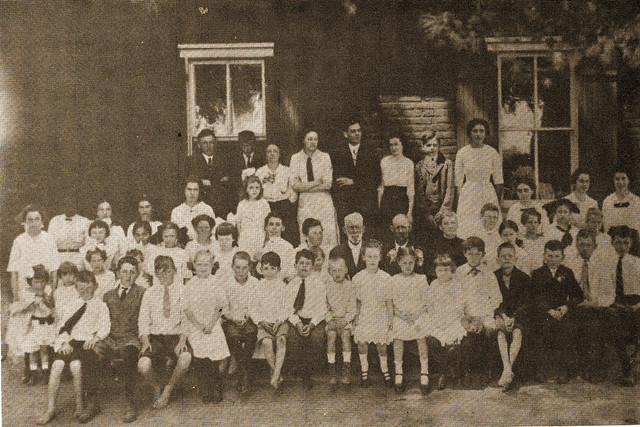
This picture was taken at the side of Shepherd's Grade School around 1912. It was loaned to SCHOOL NEWS by Christine Walper Knott of Molers Cross Roads, one of the students pictured. She says that the picture was taken on the last day of school when parents came for a picnic. Pictured:
front row are: Russell Morgan, Walter Myers, Stewart Morgan, (?) Billmyer, (?) Coffinberger, Kenneth Powell, Thomas Turner, Holland Coffinberger, (?) Coffinberger, Charlotte Hill Moler, Vernice Houser Morgan, Luther Vickers, Vernon Foutz, William Walper, Lawrence Vickers, and Edward Vickers.
Second row: Elizabeth Morrow Bussey, (?) , Charlotte Foutz, (?) partially hidden.
Third row: Bernice Johnson Walper, Laura Stevenson, Christine Walper Knott, (?)-, Irene Hill Sutton, Helen Lemen, Imogene Walper Webber, Mrs. Pearl Turner, Mrs. Coffinberger, Mr. William Martin, Mr. Gus Morgan, Mrs. Ella Beltz, Mrs. Georgia Walper, Ruth Beltz, Mabel Foutz, Isabel Martin Reiter, and Marguerite Billmyer.
Fourth row: Maude Kisner, Edna Geigas, (?) Foutz, Mary Butler, far right of picture: Miss Virginia White, Florence McQuilkin Walper (teach*er), Margaret Foutz. Fifth row: Joe Walper, Jr., Franklin McQuilkin, Mrs. Vergie Morrow, Hazel Martin, Harry White, Lucy McQuilkin, Leo Walper, and Ethel Kisner.
School Improvement League
organized in Jefferson County – 1904
In 1904, an organization called the West Virginia Improvement League was organized in Jefferson County.
According to the first organizational papers, loaned to SCHOOL NEWS by Mrs. Creighton Tabb, s. Samuel St., Charles Town, the pruposes of the group were:
Approximately 100 Jefferson County residents had joined the league by 1906.
Jefferson County School Superintendents 1865-Present
The position of county superintendent of schools was established in West Virginia in 1863 when the new state passed legislation to establish a free school system.
Jefferson County elected its first superintendent in October, 1865. Samuel V. B. Strider was elected for a two-year term with a $250 annual salary.
Those superintendents who followed Strider are listed below:
1865-1867 - Joseph Barry, graduate of University of Dublin.
1867-1869 - James Grubb, civil engineer and teacher.
1869-1870 - G. G. Baker, Methodist minister.
1870-1871 - N. C. Brackett, graduate of Darmouth College and first principal of Storer College.
1872-1874 - William L. Wilson, first Democrat (Conservative) to be elected
after the Civil War; graduate of Columbia College and assistant professor of ancient languages at Columbia.
1874-1875 - Dr. A. Tinsley, assistant surgeon in the Confederate Army, medical degree from the New York University Medical College; stationed with Lee's army at the Battle of Sharpsburg and was ordered to prepare Shepherdstown for the reception of Confederate wounded; after the battle, stationed in Shepherdstown for four months in charge of the dangerously wounded; moved to Shepherdstown in 1872.
1875-1887 - John Hess, a school teacher for 50 years and superintendent for 12 years; led a period of growth and progress in Jefferson County Schools.
1887 - Frank Hess, son of John Hess, filled term caused by his father's death.
1887-1891 - Emanual Schaeffer, teacher.
1891-1893 - George Ramsburg, graduate of Shepherd College.
1893-1899 - A. P. Neel, Methodist minister.
1899-1907 - J. A. Engle, teacher for 40 years, including several years at Oak Grove School in Bakerton.
1907-1911 - E. Turner, graduate of Shepherd College and teacher for 27 years.
1911-1919 - James Grantham, deputy sheriff and teacher.
1919-1935 - 1. N. Bonham, high schools in Charles Town, Harpers Ferry, and Shepherdstown constructed during this period; many schools consolidated; transportation of pupils extended.
1935-1948 - H. M. Sydnor, native of Rome, Georgia; graduate of Hampden-Sydney College and University of Virginia; teacher, businessman, and principal of Harpers Ferry High School.
1948-1971 - T. A. Lowery, native of Norfolk, Virginia; graduate of Shepherd College and Columbia University; teacher at Harpers Ferry High, principal of Stanley High School, Stanley, Virginia, and principal of Charles Town High School; served as superintendent for 23 years, longer than any other person holding the position.
1971-present - Harold L. Pickens, native of Letter Gap, West Virginia; graduate of West Virginia University; businessman, teacher, and principal.
Designs SCHOOL NEWS Heading
Jefferson High junior Steve Cline designed the bicentennial heading for this issue of SCHOOL NEWS.
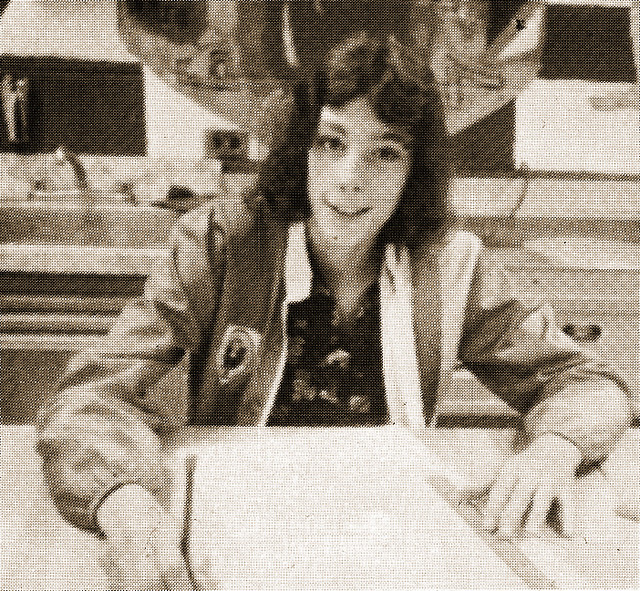
Steve is the son of Mr. and Mrs. Donald Cline of Charles Town. He is enrolled in Art III at Jefferson and says his favorite art form is abstract drawing.
Steve is a member of the Cougar tennis team and plays intramural sports at Jefferson.
In 1976 Jefferson County School News was a monthly publication sponsored by the Board of Education as a public service to Jefferson County residents.
Superintendent - Harold L. Pickens
President of the Board - Richard Neal
Editor - Mary Stocks
Special thanks are due to the following people who so willingly supplied information to the editor of this paper for this special publication:
Miss Gladys Hartzell, Mrs. Mary Baum, Mr. and Mrs. Robert Rissler, Mr. Mayo Snyder, Mr. Charles Reinhart, Mrs. Augusta Phillips, Mr. Franklin McQuilkin, Miss Helen Goldsborough, Mr. Joe Walper Mr. Oscar Jones, Mrs. Mary Donley Reinhart, Miss Mildred Conard, Rev. Lester Link, Mr. Kerfoot Moler, Mrs. Adora Payne, Mrs. J. W. Link, Mrs. Elsie Garrett, Mrs. Robert Knott, Mr. Thomas Turner, Mrs. Marion Creamer, Mr. Arthur Prather, Mrs. Robert Knott, Mr. B. M. Dennis, Mrs. Mary Ennis, Mr. Jesse Engle.
Jefferson County Public Schools
Shepherdstown District School History
1847-1933

Two residents of Shepherdstown, Arthur Prather and Gladys Hartzell, are pictured at the stone foundation which is all that remains of Potomac School, probably built in 1847. The foundation is directly behind the Carolyn Apartments.

When Jefferson County voters on June 3, 1847, (see SCHOOL NEWS "Looking Back," January, 1975) voted to establish a free public school system, Shepherdstown was divided into two school districts. The western part of town was the Potomac District while the eastern part was the Shepherd District, and each district was responsible for maintaining a schoolhouse.
According to Musser's HISTORY OF SHEPHERDSTOWN, a lot was purchased that same year at the extreme west end of Washington Street for the erection of a school building for the Potomac District. It was a one-room brick building and was called Potomac School.
The school stood 200 feet north of the entrance of Leeland, now the home of Miss Helen Goldsborough whose grandmother attended Potomac School.
The Shepherd District purchased a lot in 1849 at the intersection of Princess and New Streets for $100 from Samuel Baker, Henry Taylor, and John White. A one-room brick school was erected on this lot and was called Shepherd School.
The Potomac and Shepherd Schools were both in operation until 1880 when the commissioners of the two districts joined to purchase the old county jail building on the northwest corner of High and King Streets in Shepherdstown for use as a consolidated school.
Potomac School was sold in 1881 to Edmund Lee, the great-grandfather of Helen Goldsborough, for $416.50. Lee lived at Leeland and probably rented the school as a private dwelling. Later, an Annie Washington lived in the school for many years. Finally G. L. Waltz purchased the school and tore it down a few years ago.
The stone foundation is all that remains of Potomac School. The Carolyn Apartment complex owned by G. L. Waltz sets directly in front of the foundation.
Shepherd School was sold in 1881 to a William L. Reinhart for $383. For many years the school was used as a private dwelling and later as a grocery store by Frank Carter.
In 1944, Shepherdstown Mayor U. S. Martin purchased the building from Carter. After Martin's death in 1957, his son Upton Martin of Richmond, Va., became owner of the former school.
In 1961, Upton Martin deeded the school to the State of West Virginia for Shepherd College in memory of his father who had been a leading citizen of Shepherdstown for over 50 years.
The little red brick school still stands today. The Historic Shepherdstown Commission is in the process of restoring the building. The restoration of the outside of the school is complete, but the Commission's plans to authentically restore the inside have not been completely carried out to date.

Shepherd School still stands today on Princess Street in Shepherdstown. It was built soon after Jefferson County voters established a free school system in 1847.
In 1881 the commissioners of the two districts joined to purchase the old county jail building on the northwest corner of High and King Streets in Shepherdstown.
The building had been used from 1865 until 1871 as a jail when the county seat had been located in Shepherdstown.
A portion of the old jail was repaired and converted into classrooms and was used as a school until 1900 when a ten-room brick school building was erected on the same lot. The jail was razed when the new school was ready for occupancy.

Shepherdstown Graded School - 1900
The new Shepherdstown Graded School served grades one through eight until 1920 when a ninth grade class was added. This addition was the first experience in public high school education for Shepherdstown. Since 1872, students above the eighth grade had paid tuition to attend high school at Shepherd College.
The new ninth grade class was taught by the school's principal George Knode. This arrangement continued until 1922 when the Board of Education rented McMurran Hall, then called "Old Shepherd College Building," to organize a secondary program for grades 9-11.
According to the Shepherdstown District Board of Education minutes of 1925, Shepherdstown Graded School was rented during the summer months for $50 by Shepherd College for use as a summer school.
The rent originally was set at a much higher rate, but in return for the Board's lowering the rent, the college offered a summer class in remedial work to any eighth grader who needed to make-up school work.
It seems that the college and the school maintained a close working relationship throughout the years. College students in training to become teachers often worked in the graded school. In fact, in 1931, there were so many first graders enrolled at Shepherdstown Graded School that a college student was obtained to ''take over the teaching of some."
Shepherdstown Graded School served both the students of Shepherdstown and of the surrounding rural areas. The consolidation of the rural schools into the Shepherdstown School was always a main goal of the Shepherdstown District Board of Education.
In 1915 the Shepherd's Grade School was closed to consolidate with Shepherdstown. Oak Grove followed in 1917, Molers Crossroads and Uvilla in 1928, and Duffields and Edgewood in 1929. Shepherdstown Graded School continued to operate until 1957 when it was replaced by the present Shepherdstown Elementary School in Little Run Acres.
The graded school built in 1900 is now a part of the Shepherd College campus, used as the social sciences building until recently. The building will be razed in the near future to clear the site for a new college building to house the home economics and nursing departments.
Black Schools
Because of the lack of records, it is not possible to establish the exact date for the building of the first school for black students in Shepherdstown.
However, the building still stands today on Brown's Alley.

It was a one-room brick school called Old School which operated until 1883 when Shadyside, a larger frame structure on West High Street was rebuilt to replace it.

The Old School is the property of the Asbury Methodist Church and until recently has been used as a private dwelling.
School commissioners purchased the lot for Shadyside from a R. A. Hessey for $65. This larger school operated until it was replaced by Eastside School in 1948.
Shadyside was sold in 1948 to Knode Tennant for $910. Later it was sold to Belle Allen who operated a tavern in the former school for many years. Today Shadyside is owned by the heirs of Belle Allen, but it is not being used for any purpose.
Shepherdstown Begins High School Program
In 1922, the Shepherdstown District Board of Education offered for the first time a high school program beyond the ninth grade.
Two years earlier a ninth grade class was started at Shepherdstown Graded School, but students beyond the ninth grade still paid tuition to attend high school at Shepherd College.
The secondary program organized in 1922 served grades 9 -11 in the "Old Shepherd College Building" (McMurran Hall) which was rented from the State of West Virginia by the Board.

The old Shepherd College Building (McMurran Hall) was used as a high school from 1922 - 1939
In 1926 a full high school program for grades 9 -12 became a reality. John Lowery, father of former Superintendent of Schools, T. A. Lowery, served as principal and mathematics and Latin teachers. English was taught by Gladys Hartzell and three other staff members taught social studies, science, agriculture, and home economics.
The Board of Education set high standards for its high school students. A policy formulated in 1924 stipulated that any scholars who failed in two subjects in the first semester would be dropped from school and not allowed to continue their studies without permission from the Board.
Seven students failed at least two subjects in the first semester of 1924. Six were allowed to return if they could pass an examination on the subjects failed and if they passed all subjects at the end of the second semester. The other student had failed all subjects and was not allowed to return to school.
The college building was evidently less than satisfactory for use as a high school. R. Emerson Langfitt of the West Virginia Department of Education visited the high school in 1927. His evaluation, quite critical of the facilities, mentioned that one room was being used as a library, principal's office, study hall, classroom, lunch service room, and locker room. He pointed out that most of the books in the library were textbooks and that no toilet facilities were available.
However, many citizens of the Shepherdstown District were not in favor of building a new high school. Bond issues to provide a new high school were put before the public twice in 1924 and again in 1927. All three times, the levies were defeated by a heavy margin.
It was not until 1928 that a $40,000 bond issue was finally passed, 778 votes for and 291 against. High school classes continued to be held at McMurran Hall until the new high school was completed in 1930.
The new Shepherdstown High School was built on a five-acre lot purchased from the Baltimore and Ohio Railroad for $4000. F. 0. Trump was, awarded the construction contract for $33,000.

Shepherdstown High School - 1930
The new school served grades 7-12 until 1971 when grades 10 -12 were moved to a new consolidated county high school on the Flowing Springs Road.
The school is now Shepherdstown Junior High serving grades 7 - 9.
Lemen (Oak Grove) School

One of the earliest public schools in Jefferson County was built on the Lemen farm, one mile west of Shepherdstown on the Martinsburg road.
The deed for property was recorded in 1857. Willoughby and Esther Lemen sold the lot to the school commissioners for $40. However, the school must have been built prior to 1857.
A cornerstone, now on the front corner of the Jefferson County Court House, was placed on the Lemen School in 1851 to honor John Yates, the first president of the county school commissioners elected in 1847 to implement a system of public schools in Jefferson County.
Lemen School is better known to Shepherdstown residents as Oak Grove School. The one-room school continued to operate until 1917 when it was consolidated with Shepherdstown Graded School.
In 1926, Oak Grove was sold to the estate of David Lemen for $150. The school was torn down some years ago. Today the former site of the school is part of the Fred Gates property.
Edgewood Schools

Edgewood School, 1904 - Now a Private Residence
According to Mayo Snyder of Martinsburg, a former student of Edgewood School, there has been a total of three Edgewood Schools, the first two destroyed by fire.
It is unknown when the first Edgewood School was built. The earliest deed recorded is for the year 1879 when a George Moore deeded to the Board a lot "on the road leading from the Ridge Road to Walper's Cross Roads" for one dollar as long as the land was used for school purposes.
Snyder does not know whether the 1879 school was the first or second Edgewood, but he does know that both schools were built in the same general area.
Sometime around 1904 the second Edgewood School was destroyed by fire and the third Edgewood was built, again in the same general area.
The last Edgewood was a one-room brick school which still stands today. It was used until 1929 when it was consolidated with Shepherdstown Graded School.
In 1930 Edgewood was sold to a Gilbert Hendricks for $450. Today the school is owned by Clarence Dunn who uses it as a private residence.
An interesting story concerning Edgewood is told by Joe Walper of Shepherdstown who attended the school in the early 1900's. He says that some of his classmates used to set the clock up to trick their teacher, Annie Eickelberger. He remembers being sent home many days at 1:30 pm when his teacher looked at the clock and announced it was 4 pm.
Unionville (Uvilla) Schools
Although it is not known when the first public school in Uvilla (formerly Unionville) was established, it is known that there was a school there in 1850.
Gladys Hartzell in her book, ON THIS ROCK, THE STORY OF ST. PETER'S CHURCH, quotes from the church records: "In 1850 the Lutherans ceded their interest in Zion Church (Bakerton) to the Presbyterians and held services, conducted by the Reverand Dr. Schmucher in the old log school house at Unionville."
The Lutherans continued to meet in the school until they erected their first church called Luther Chapel in 1856 on adjacent property owned by Isaac Dust.
The school house was also on Dust property. The deed for the school lot was not recorded until 1872. The deed states that for one dollar, Isaac Dust granted the northwest corner of the Lutheran Church lot to the school commissioners as long as the land was used for school purposes. The land was to revert to the family if a school house ceased to be located there.
It is not known why the deed was recorded so many years after the school was erected. Perhaps the school existed as common school before the public school education was established in Jefferson County in 1847. In any case, it was not uncommon for landowners to have schools built upon their property without any kind of deed transfer.
The first Uvilla school was used until around 1897 when it was replaced by a two-room brick school which still stands today. Now a private residence, the school is located next to the Lutheran Church which was built in 1896 to replace Luther Chapel.

Although many changes have been made to the building pictured, the original structure was built in 1897 as the Uvilla school. It replaced an earlier school which dated back at least to 1851. Today the school pictured is the home of Marion Creamer.
The new brick school served the Uvilla area until 1928 when it closed to consolidate with Shepherdstown Graded School.
In 1929, a Mr. Merchant bought the school from the Board of Education for $400. Merchant remodeled the school for a private dwelling. Today his daughter, Marion Creamer lives there. She recalls that when her father bought the school, the Board moved the blackboards and desks to the nearby Skeetersville School.

This picture was taken in front of the Uvilla School around 1912. It was loaned to SCHOOL NEWS by Mildred Conard, a long-time resident of the Uvilla area. Pictured:
Front row are: ?, Richard Hawn, ? , Olin Hawn, ? , Daniel Engle, ? , Franklin Jones, Howard Albin, and Gilbert Hendricks.
Second row: Betty Engle, ? , Agnes Comer Gay, ? , Ruth Myers, Anna Hendricks Edwards, Kenneth Engle, and Mary Hendricks Ennis.
Third row: ? , Gladys Moler, and Bessie Henkle Welsh.
Fourth row: Jesse Engle, Viola Engle, ? , ?
Fifth row: Meta Jenkins, Grace Comer, Helen Link (teacher) and Lallie Maddex (teacher).
Moler's Crossroads Schools
According to life-long residents of Moler's Cross Roads, there have been at least three schools in the small community.
Of these three, only the first still stands today. It is located one and one-half miles out of Molers Cross Roads on the road to Shepherdstown and is now the residence of Sidney Jenkins.

This home, one and one-half miles outside of Moler's Crossroads, was originally a one and one-half story log building used as a school in the 1840's.
According to Kerfoot Moler, a descendant of the Molers for whom the community is named, his great aunt Victoria Moler, born in 1842, went to this school.
This school was originally a one and one-half story log building, but of course many changes have been made over the years. The former school is now a two-story home with several rooms added.
It is not known whether this school was a common or private school, but it probably remained open until the Reinhart School was built, sometime around 1850.
The exact date the Reinhart School was erected is not known. In 1860 Christian Reinhart deeded the school commissioners the lot on his farm where the school stood, but the school was built several years before.
The Reinhart School can be traced back as early as 1851 according to Mrs. Nellie Hendricks Moler in her booklet, "History of the Founding of Bethesda M. E. Church South," written in 1934.
In writing the church history, Mrs. Moler found that the Reinhart School was used for many years as a church meeting house before the Bethesda Church was built in 1874. The following excerpts from the booklet tell much about the Reinhart School.
"Bethesda is sixty years old. The History of Bethesda needs to go back to the old Reinhart Schoolhouse days, when that schoolhouse was the center of a rural community church on the Sabbath day, and the forum of the "Three R's" on week-days.
It was a brick structure, built on land owned by Christian Reinhart, and now owned by Dr. S. T. Knott. The lot was at the east edge of a beautiful woodland of oaks and hickories, on the road leading to Dr. Knott's home. It faced the road, with three windows on either side and none at the back.
This building was used for school during the week, and on Sunday in the afternoons, for services; class meeting, singing, Bible reading, Sunday School; and at night, prayer meeting.
The first record of a service held in Reinhart's Schoolhouse was in 1851. At that time, it was recorded as one of the classes on "Shepherdstown Circuit," and called "Class No. 7," leader and "exorter" Michael Nichols. There were eleven classes-two being for colored slaves but having white leaders-and all held at different places."
Reinhart School was torn down in 1880 when it was replaced by a school built on property sold to the Board of Education by D. G. Moler (grandfather of Kerfoot Moler) for $45. The bricks from Reinhart were used as filler in the walls of the new school which also came to be known as Reinhart School.

Kerfoot Moler, a descendant of the Molers for whom Molers Crossroads is named, stands on the stone foundation of the second Reinhart School, built in 1880. The school was built on land sold to the school commissioners by his grandfather, D. G. Moler. The school stood approximately 150 yards north of the Bethesda Church.
According to Mary Reinhart Donley, another life-long resident of Molars Cross Roads, the new school was originally a one-room school, but around 1899 a second room was added. Mrs. Donley was both a student and a teacher at this school.
Reinhart School finally closed in 1928 to be consolidated with Shepherdstown Graded School. In 1929 the school was sold to the heirs of D. G. Moler for $475. The school was torn down a few years ago, and the former site of the school is the property of E. G. Moler, brother of Kerfoot Moler.

These school children were students of the Reinhart School built in 1880. This picture, loaned to SCHOOL NEWS by Kerfoot Moler, was taken sometime in the early 1900's.
Front row are Mabel Thompson, Phoebe Knott, Kerfoot Moler, Peck Hoffman, Eva Knott Spring, Dovie Walters, and Margaret Skinner Shultz.
Back row are Christian Carter, Charles Myers, Jacob Myers, Charlotte Carter Lowe, Charles Springer, Maude Marshall Sager, Margaret Dobson, Lily Marshall, and Inez Moler. The teacher is Bess LaMar Rau.
Duffields Schools
In 1870, the Elk Branch Church in Duffields built a school for the community next to the church. The school was called The Academy and was the only school in Duffields until the Shepherdstown District Board of Education built a school nearby in 1885.

The Academy - 1870
Land was purchased for the school from a John Harman for $125. A one-room school was built and was originally used for grades five through eight, while the younger students continued to attend school at The Academy.
Although the exact date is unknown, The Academy was eventually closed and the Duffields School began to serve all eight grades until it was consolidated with Shepherdstown Graded School in 1929.

The Duffields School - 1885
Today both The Academy and Duffields School still stand. The Academy is used by Elk Branch Church for community meetings and suppers. Duffields School was sold in 1934 to Dr. W. J. Melvin for $135. His daughter, Mrs. Robert Rissler of Duffields, owns the school building today.
The school for black students in the Duffields area was called Skettersville School. It still stands today one mile from Duffields on the Duffields-Uvilla Road.

Skettersville School
It is unknown when this school was established since there are no early records of the Shepherdstown school district.
The deed for the property was recorded in 1920 showing that the building and the land was sold to the Board of Education by a James Mason, Jr. for $850. However, the school was in use at least by 1912.
According to B. M. Dennis of Harpers Ferry, teacher at Skeetersville around 1913, the building was originally a private residence with one room rented for use as a school.
In 1924, patrons of the Duffields area asked the Board to furnish new and better quarters for the school, but no action was ever taken.
Skettersville continued to operate until 1937 when it was sold for $275 to a Nathaniel Gray who rented it as a private residence. Today the former school is the home of James Motten.
Shepherd Grade Area
Turner School and Shepherd's Grade School
Turner School was built in 1770 as a private school but it later became a public school serving students in the Shepherd Grade area.

Shepherd's Grade School, now a Private Residence
According to Thomas Turner, a descendant of the original owners of Turner School, it was probably not until the later part of the 19th century that Turner School finally closed its doors.
The school was located three miles north on the road to Scrabble from Shepherdstown. Turner believes it was destroyed by fire.
Turner School was replaced by Shepherd's Grade School, a one-room brick school about four miles out of Shepherdstown on Shepherd Grade.
It is believed Shepherd's Grade School closed around 1915 when it was consolidated with Shepherdstown Graded School.
The Board of Education rented the school as a private dwelling for several years. The 1924 Board minutes report that ''for the better comfort and accommodation of the renters of the Shepherd Grade School, a partition be added."
In 1926 the school was sold to Luther Vickers for $20. Today the former school is the home of John Fraley, Jr., who has made many changes and additions to the building.

This picture was taken at the side of Shepherd's Grade School around 1912. It was loaned to SCHOOL NEWS by Christine Walper Knott of Molers Cross Roads, one of the students pictured. She says that the picture was taken on the last day of school when parents came for a picnic. Pictured:
front row are: Russell Morgan, Walter Myers, Stewart Morgan, (?) Billmyer, (?) Coffinberger, Kenneth Powell, Thomas Turner, Holland Coffinberger, (?) Coffinberger, Charlotte Hill Moler, Vernice Houser Morgan, Luther Vickers, Vernon Foutz, William Walper, Lawrence Vickers, and Edward Vickers.
Second row: Elizabeth Morrow Bussey, (?) , Charlotte Foutz, (?) partially hidden.
Third row: Bernice Johnson Walper, Laura Stevenson, Christine Walper Knott, (?)-, Irene Hill Sutton, Helen Lemen, Imogene Walper Webber, Mrs. Pearl Turner, Mrs. Coffinberger, Mr. William Martin, Mr. Gus Morgan, Mrs. Ella Beltz, Mrs. Georgia Walper, Ruth Beltz, Mabel Foutz, Isabel Martin Reiter, and Marguerite Billmyer.
Fourth row: Maude Kisner, Edna Geigas, (?) Foutz, Mary Butler, far right of picture: Miss Virginia White, Florence McQuilkin Walper (teach*er), Margaret Foutz. Fifth row: Joe Walper, Jr., Franklin McQuilkin, Mrs. Vergie Morrow, Hazel Martin, Harry White, Lucy McQuilkin, Leo Walper, and Ethel Kisner.
School Improvement League
organized in Jefferson County – 1904
In 1904, an organization called the West Virginia Improvement League was organized in Jefferson County.
According to the first organizational papers, loaned to SCHOOL NEWS by Mrs. Creighton Tabb, s. Samuel St., Charles Town, the pruposes of the group were:
- To co-operate with the Agricultural Experiment Station of West Virginia Uiversity in enlarging, improving, and beautifying West Virginia School grounds
- To improve and beautify west Virginia School Buildibgs, (within and without).
- To establish and maintain libraries in West Virginia.
Approximately 100 Jefferson County residents had joined the league by 1906.
Jefferson County School Superintendents 1865-Present
The position of county superintendent of schools was established in West Virginia in 1863 when the new state passed legislation to establish a free school system.
Jefferson County elected its first superintendent in October, 1865. Samuel V. B. Strider was elected for a two-year term with a $250 annual salary.
Those superintendents who followed Strider are listed below:
1865-1867 - Joseph Barry, graduate of University of Dublin.
1867-1869 - James Grubb, civil engineer and teacher.
1869-1870 - G. G. Baker, Methodist minister.
1870-1871 - N. C. Brackett, graduate of Darmouth College and first principal of Storer College.
1872-1874 - William L. Wilson, first Democrat (Conservative) to be elected
after the Civil War; graduate of Columbia College and assistant professor of ancient languages at Columbia.
1874-1875 - Dr. A. Tinsley, assistant surgeon in the Confederate Army, medical degree from the New York University Medical College; stationed with Lee's army at the Battle of Sharpsburg and was ordered to prepare Shepherdstown for the reception of Confederate wounded; after the battle, stationed in Shepherdstown for four months in charge of the dangerously wounded; moved to Shepherdstown in 1872.
1875-1887 - John Hess, a school teacher for 50 years and superintendent for 12 years; led a period of growth and progress in Jefferson County Schools.
1887 - Frank Hess, son of John Hess, filled term caused by his father's death.
1887-1891 - Emanual Schaeffer, teacher.
1891-1893 - George Ramsburg, graduate of Shepherd College.
1893-1899 - A. P. Neel, Methodist minister.
1899-1907 - J. A. Engle, teacher for 40 years, including several years at Oak Grove School in Bakerton.
1907-1911 - E. Turner, graduate of Shepherd College and teacher for 27 years.
1911-1919 - James Grantham, deputy sheriff and teacher.
1919-1935 - 1. N. Bonham, high schools in Charles Town, Harpers Ferry, and Shepherdstown constructed during this period; many schools consolidated; transportation of pupils extended.
1935-1948 - H. M. Sydnor, native of Rome, Georgia; graduate of Hampden-Sydney College and University of Virginia; teacher, businessman, and principal of Harpers Ferry High School.
1948-1971 - T. A. Lowery, native of Norfolk, Virginia; graduate of Shepherd College and Columbia University; teacher at Harpers Ferry High, principal of Stanley High School, Stanley, Virginia, and principal of Charles Town High School; served as superintendent for 23 years, longer than any other person holding the position.
1971-present - Harold L. Pickens, native of Letter Gap, West Virginia; graduate of West Virginia University; businessman, teacher, and principal.
Designs SCHOOL NEWS Heading
Jefferson High junior Steve Cline designed the bicentennial heading for this issue of SCHOOL NEWS.

Steve is the son of Mr. and Mrs. Donald Cline of Charles Town. He is enrolled in Art III at Jefferson and says his favorite art form is abstract drawing.
Steve is a member of the Cougar tennis team and plays intramural sports at Jefferson.
